What is an Eel?
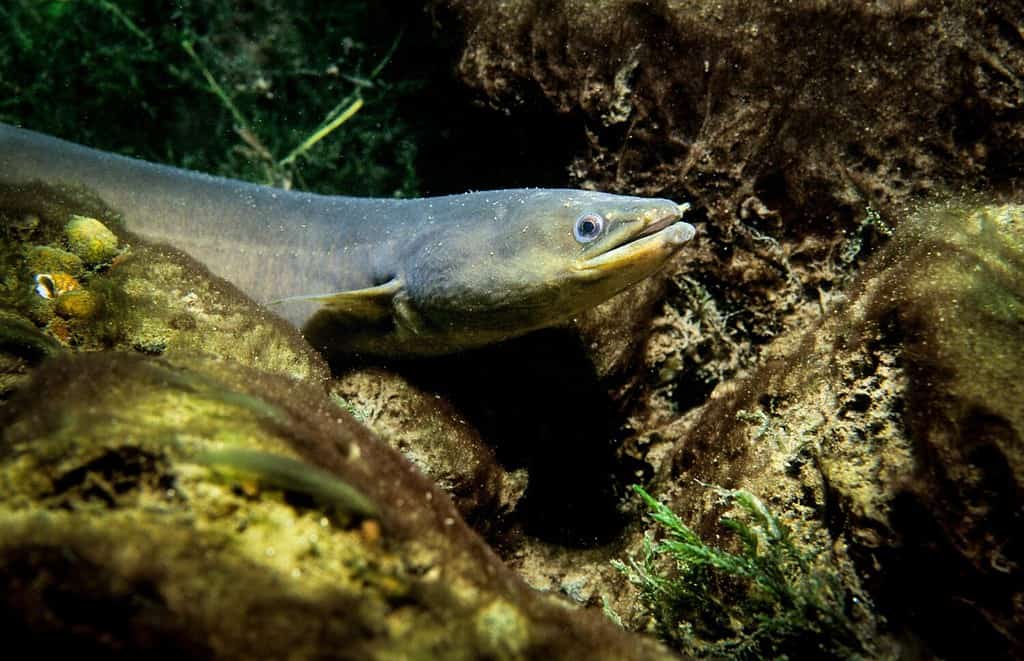
The American eel is a complicated and mysterious animal.
©RLS Photo/Shutterstock.com
In a world of fascinating animals, the eel takes one of the top spots. The lifecycle of eels is very unique. Baby eels begin life as larvae and undergo four metamorphoses before becoming adults. There are over 1,000 types of eels from twenty different families. Each family contains different subspecies with unique adaptations. While they look like snakes, eels belong to the ray-finned fish classification of Anguilliformes. Did you know that electric eels aren’t true eels? Electric eels belong to Gymnotiformes, or the knife fish family.
How Baby Eels Are Born
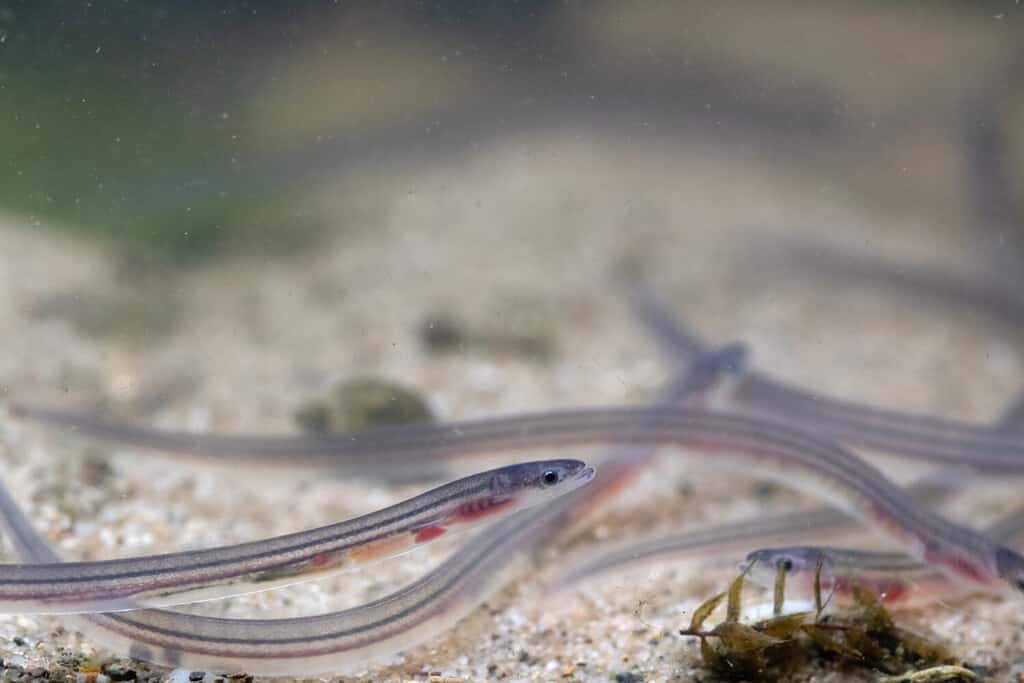
As eels enter their second stage of life, they’re called glass eels. These tiny, transparent eels are considered a delicacy.
©jack perks/Shutterstock.com
Like amphibians, the mother eel will lay eggs in the water, which are fertilized by male eels. These eggs develop for several days before hatching into the next stage of life. A mature eel’s gender appears determined by environmental factors. Eels that reach maturity surrounded by mostly male eels will frequently mature into female eels. Eels that mature into adulthood with primarily female eels will more often be male. Eels, however, spend a large portion of their lifecycle without gender.
Baby Eels Begin Life as Larvae

Leptocephali have flat bodies filled with jelly-like substances, surrounded by a thin muscle layer. Their gut is a simple tube, and they lack pelvic fins.
©Kils / CC BY-SA 3.0 – License
Larvae generally bring insects to mind, but these fish begin life as larvae. The eel larva is called leptocephali. This larva is flat and transparent. Leptocephali floats on the surface of the water, carried by ocean currents. The larval eel feeds on phytoplankton until they metamorphose into a glass eel. This process can take one to three years. Glass eels lack the necessary cells to produce color. However, once glass eels reach their destination, these cells develop and eels gain color.
Amazingly, eels in their larval stage have teeth. As they approach maturity to metamorphosis, these larval teeth fall out and stronger teeth emerge.
Leptocephali is Becoming Rare

Common methods of cooking eelpout include basking, frying, roasting, and stewing.
©AJSTUDIO PHOTOGRAPHY/Shutterstock.com
Glass eel is a dining delicacy in Asia. Due to overfishing and poaching, some eel subspecies, such as the European eel, are critically endangered. In addition, man-made obstacles to migration and loss of habitat to pollution are contributing factors. Excessive fishing of eel in the early stages of their lifecycle has resulted in fewer adult eel reproducing.
The Study of Baby Eel Can’t Determine the Subspecies
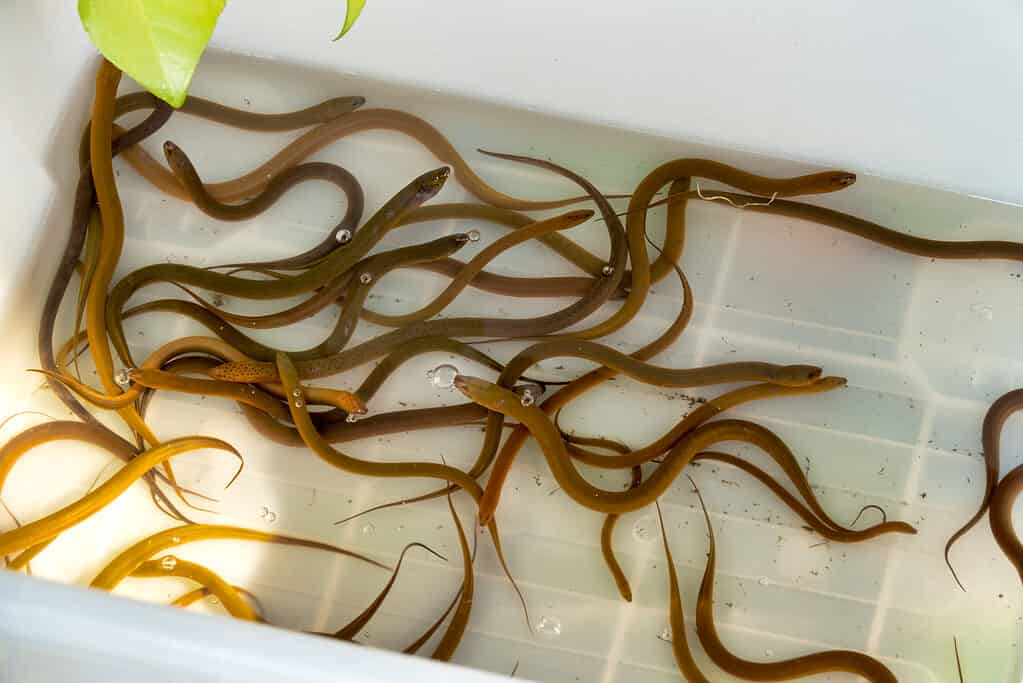
Studying Leptocephali can’t tell scientists what type of eel the larvae will be.
©iStock.com/only_fabrizio
Classification of eels relies on several physical traits. Fins, internal organs, teeth shape, and position, as well as other physical traits, determine family groups. For this reason, the study of eel in their larva stage isn’t able to determine the expected eel population. Baby eels have not developed these distinguishing traits, and won’t for several years. The study of eels that have reached maturity is the only way scientists can estimate the population of any given type of eel. This hampers conservation efforts, as eels are difficult to breed in captivity.
Glass Eels May Use Magnetic Fields for Navigation

While it provides excellent breeding grounds for eels in the Sargasso Sea where it originates, Sargassum seaweed is unwelcome when it washes up on the shores of Florida.
©iStock.com/Marcial Gonzalez
Every American and European eel began life at a single spot in the Sargasso Sea, and will return to the same area to reproduce. Baby eels appear to follow a magnetic map from their spawning point in the Sargasso Sea. Named for the brown sargasso seaweed that grows in the area, the Sargasso Sea is a region in the Atlantic Ocean bordered by four currents. The Gulf Stream, North Atlantic Current, Canary Current, and North Atlantic Equatorial Current all combine to create a pocket of ocean water. This pocket rotates in a counter-clockwise motion and is named the North Atlantic Gyre. Scientists haven’t determined how they achieve this, but have noted that older eels tend to have a lessened ability when returning to spawn. The changes in navigational ability may be due to physical changes eel experience through their lifecycles. Over their lives, eels will travel up to 6,000 miles to and from their spawning points.
The Lifecycle of Eels
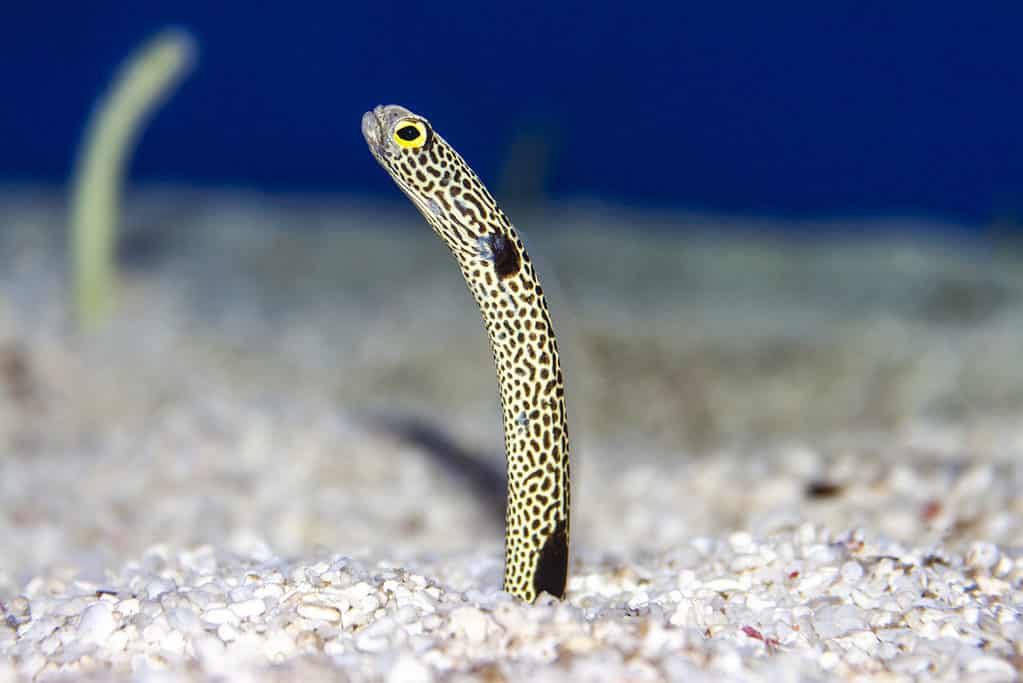
Eels will spend the majority of their lives as elvers.
©iStock.com/Michael Wallis
Following the larval and glass eel stage, eels migrate to rivers and ponds. There, they mature into elvers. These eels will live in their freshwater habitats for up to twenty years before returning to the ocean to reproduce. All European and American eels are born in the Sargasso Sea. This region of the Atlantic Ocean is unique due to several features. Instead of land, boundaries to this region are ocean currents. The Gulf Stream, North Atlantic Current, Canary Current, and the North Atlantic Equatorial Current isolate the waters of the Sargasso Sea. There, the eel will spawn and die, completing its life cycle. For unknown reasons, eels’ stomachs dissolve before migration. They make the journey on stored energy alone.
Migrating Eels Sometimes Travel Across Land

You just might see an eel on land. During migration, eels sometimes cross land to reach other water sources.
©Didier Barriere Doleac/Shutterstock.com
When migrating, eels sometimes travel across grassy areas to reach water and continue their journey. Eels breathe through their skin during land travel and can survive on land for several hours. While in water, eels use their gills to breathe. Known as cutaneous respiration, it’s a trait eels share with frogs, toads, salamanders, and earthworms.
Eels Do Have Scales
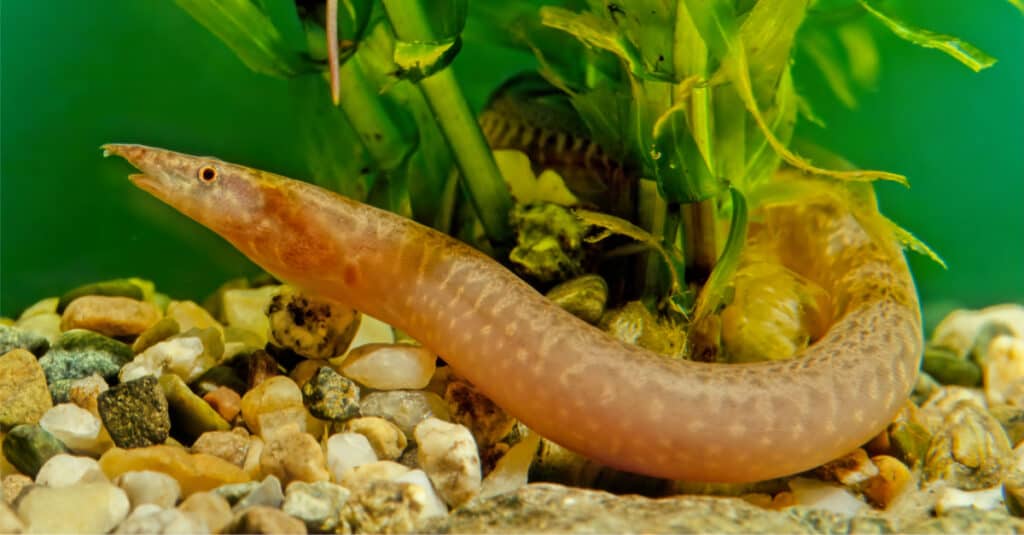
Contrary to popular belief, eels have small scales deeply embedded in their thick skins.
©iStock.com/Miropa
Due to their soft skin, eels were once thought to not have scales. Eel scales are small and embedded in their skin. In addition, eels produce a layer of mucus, like all fish. This mucus helps the eel evade capture and protects its skin from water. Removing this layer of mucus from the skin of an eel will kill the eel. Some eels, like the Moray, have mucus that contains toxins. These toxins live on the fish’s body and mouth. Moray eel mucus contains hemagglutinin, a toxin that causes red blood cells to clump, as well as a toxin that destroys red blood cells. This is another trait eels share with some species of frogs.
Eel Blood is Toxic to Humans

Unagi Eel Nigiri Sushi. All eel is cooked before consumption as eel blood contains potent toxins. Heat destroys these toxins, making meat safe to consume.
©MaryLucky/Shutterstock.com
While the mechanics of the toxin present in eel blood aren’t known, raw eel blood is toxic to mammals, including humans. Exposure causes large muscles, including the heart, to cramp. Exposure to heat neutralizes this toxin, making eels safe to eat. The presence of this toxin is the reason why raw eel isn’t served in sushi or other dishes.
Eel Reproduction is a Mystery

Baby Conger eels. Despite research, scientists still don’t understand how eel reproduction works.
©Dimitri MARRIE/Shutterstock.com
To date, no scientist has managed to document the process of eel spawning. Eel reproduction is complex and not understood. Scientists know that as eel begin their journey back to the Sargasso Sea for spawning, a hormone shift occurs in their bodies. For most of the journey, the eel is not capable of reproduction. As they approach their spawning points, the eels again experience a hormone shift to allow reproduction. Scientists don’t know what triggers either process and have not been able to replicate it in captivity. Marine biologists have experimented with introducing hormones into the water of captive eels. These experiments resulted in marginal success for breeding.
The photo featured at the top of this post is © Nantawat Chotsuwan/Shutterstock.com
Thank you for reading! Have some feedback for us? Contact the AZ Animals editorial team.





